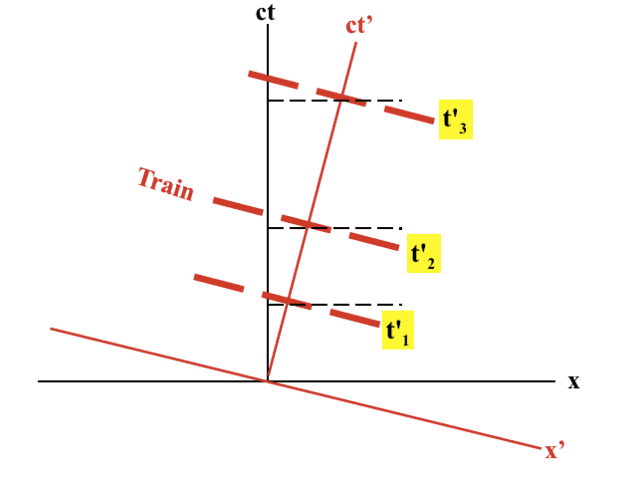Lessons From the Bizzaro Universe
The terms Bizarro and Bizarro World originated in Superman comics, where strangely imperfect versions of Superman, other action characters, and even Earth itself were conceived of, and provided the basis of stories. And who can ever forget the Seinfeld episode entitled “Bizarro Jerry,” in which there are Bizarro versions of Jerry and all his friends? But, unlike his group, the Bizarro versions are strangely nice, polite, and not self-centered.
In popular culture, Bizarro has come to mean an imperfectly flawed version of something else. So I thought it might be fun to conceptually envision a Bizarro version of our own universe. I also felt that we might gain some additional insight into the fundamental characteristics of our own universe by studying the Bizzaro universe.
Characteristics of the Bizzaro Universe
- Like the actual universe, the Bizzaro Universe is 4 dimensional, but, unlike the actual universe, the time dimension in the Bizzaro Universe is an actual spatial dimension.
- For each 3D rest frame in the Bizzaro Universe, the time dimension (direction) is oriented perpendicular to that rest frame. The 3D beings of the Bizzaro Universe cannot see into the time direction of their own rest frame, although, conceptually, they can see infinitely far in any of our other three spatial directions.
- Each rest frame in the Bizzaro Universe is traveling through Bizzaro space-time at the very high characteristic velocity c (speed of light) into its own time direction. The beings in this rest frame have no sense that this is happening since they cannot see into their own time direction. However, they can see partially into the time directions of other frames of reference that are in relative motion….in a way.
- All the clocks in each inertial frame of reference are synchronized with one another, although they may not be synchronized with the sets of clocks in other inertial frames of reference.
- All inertial frames of reference in the Bizzaro Universe are rotationally offset with respect to one another by 4D rigid rotations. To be more specific, the Bizzaro Lorentz Transformation (Borentz Transformation) in Standard Form for the Bizzaro Universe is given by: $$x’=\frac{x-vt}{\sqrt{1+(v/c)^2}}\tag{1a}$$and $$t’=\frac{(t+vx/c^2)}{\sqrt{1+(v/c)^2}}\tag{1b}$$or equivalently $$x’=x\cos{\theta}-(ct)\sin{\theta}\tag{2a}$$and$$(ct’)=x\sin{\theta}+(ct)\cos{\theta}\tag{2b}$$with$$\sin{\theta}=\frac{(v/c)}{\sqrt{1+(v/c)^2}}\tag{3a}$$and$$\cos{\theta}=\frac{1}{\sqrt{1+(v/c)^2}}\tag{3b}$$
Eqns. 2 can readily be recognized as the usual transformation equations for a rigid rotation of the coordinate axes by an angle ##\theta##. It follows from Eqns. 1-3 that the Cartesian coordinate line element in the Bizarro Universe is given by: $$(ds)^2=(dx)^2+(cdt)^2=(dx’)^2+(cdt’)^2\tag{4}$$
Unlike our actual universe which is non-Euclidean, the Bizzaro Universe is totally Euclidean. This makes it much easier to draw space-time diagrams for the Bizzaro Universe.
I should also mention that the Bizzaro Universe is, in essence, equivalent to the “loaf of bread” arrangement described in Brian Greene’s book, “The Elegant Universe.” However, for whatever reason, Greene fails to make any distinction between his Euclidean loaf-of-bread description and our actual non-Euclidean universe.
The geometry of Bizzaro Universe
In the Bizzaro Universe, as with our own universe, we refer to events as points in space-time with coordinates (ct, x, y, z), although, in the Bizzaro universe, the coordinate ct is an actual spatial coordinate. Let ##\mathbf{s}## represent a 4D position vector drawn from an arbitrary origin in Bizzaro space-time to an event (ct, x, y, z). Since Bizzaro spacetime is Euclidean, we can represent this position vector in terms of Cartesian unit vectors by the equation: $$\mathbf{s}=(ct)\mathbf{i_t}+x\mathbf{i_x}+y\mathbf{i_y}+z\mathbf{i_z}\tag{4}$$where ##\mathbf{i_t}## is the unit vector in the time direction. (Note that, in all this, we are referring to the Cartesian coordinates of events, as referenced from an arbitrarily selected origin in 4D Bizzaro spacetime.)
Suppose that we next focus on a differential 4D position vector ##\mathbf{ds}## drawn between the two closely neighboring events at (ct, x, y, z) and at (ct+cdt, x+dx , y+dy, z+dz) in Bizzaro space-time (as reckoned from a rest frame of reference S). The equation for this differential position vector is, of course, given by: $$\mathbf{ds}=(cdt)\mathbf{i_t}+(dx)\mathbf{i_x}+(dy)\mathbf{i_y}+(dz)\mathbf{i_z}\tag{5}$$The length of this differential position vector is obtained by dotting it with itself:$$(ds)^2=\mathbf{ds}\centerdot \mathbf{ds}=(cdt)^2+(dx)^2+(dy)^2+(dz)^2\tag{6}$$Eqn. 6 can be recognized is just the 4D equivalent of the Pythagorean theorem.
Suppose now there is also a second frame of reference S’ (containing 3D beings traveling with 3D velocity components ##v_x##, ##v_y##, and ##v_z## relative to our first frame of reference S) and employing Cartesian event coordinates (ct’, x’, y’,z’). If we resolve this same differential position vector ##\mathbf{ds}## into components with respect to the primed system of coordinates, we obtain:$$\mathbf{ds}=(cdt’)\mathbf{i_t’}+(dx’)\mathbf{i_x’}+(dy’)\mathbf{i_y’}+(dz’)\mathbf{i_z’}\tag{7}$$And, in terms of the primed coordinates, the length of the vector ##\mathbf{ds}## is given by: $$(ds)^2=\mathbf{ds}\centerdot \mathbf{ds}=(cdt’)^2+(dx’)^2+(dy’)^2+(dz’)^2\tag{8}$$
Since the differential position vector ##\mathbf{ds}## does not depend on the specific coordinate system or frame of reference from which it is reckoned (i.e., it is invariant under a change in frame of reference), we must immediately conclude that: $$\mathbf{ds}=(cdt)\mathbf{i_t}+(dx)\mathbf{i_x}+(dy)\mathbf{i_y}+(dz)\mathbf{i_z}$$$$=(cdt’)\mathbf{i_t’}+(dx’)\mathbf{i_x’}+(dy’)\mathbf{i_y’}+(dz’)\mathbf{i_z’}\tag{9a}$$and$$(ds)^2=(cdt)^2+(dx)^2+(dy)^2+(dz)^2$$$$=(cdt’)^2+(dx’)^2+(dy’)^2+(dz’)^2\tag{9b}$$
Eqns. 9 apply irrespective of the relative 3D velocities of the S and S’ frames of reference, or the rotational and translational offsets of the two coordinate systems.
Frames of Reference
In the present context, it is worthwhile being a little more precise about the term “frame of reference.” A frame of reference is basically a 3D x-y-z spatial cut out of 4D spacetime. The time direction t for this spatial 3D cut is oriented perpendicular to the 3 orthogonal Cartesian spatial directions of the frame of reference. Therefore, the time direction in 4D spacetime for a frame of reference S basically defines the frame of reference.
The residents of the Bizarro universe are analogous to 2-dimensional beings trapped within a flat plane that is immersed in 3D space. They have no access to the 3rd dimension, except for the 2D cross-section that they currently occupy. This 2D cross-section may not be stationary in 3D space; it may be moving forward (unbeknownst to them) into the 3rd (time) dimension. If so, as time progresses, they would be sweeping out all of 3D space, and would ultimately be able to sample all of 3D space with their planar cross-section. However, at any one instant of time (according to their synchronized set of clocks), they would only have access to a single planar slice out of 3D space.
This is totally analogous to what the 3D beings of the Bizzaro Universe are actually experiencing in their 4D spacetime. In their rest frame of reference, they are trapped within a specific 3D slice out of 4D spacetime. This 3D slice is unique to the particular reference frame they occupy (i.e., their rest frame). They have no access or vision into the 4th dimension, except for this 3D cut. The cut is not stationary; it is moving forward (unbeknownst to them) into their own 4th (time) spatial dimension. As time (measured by the synchronized clocks in their 3D reference frame) progresses, they are sweeping out all of 4D spacetime, and will ultimately be able to sample all of the 4D spacetime (at least the part into their future) with their moving 3D cut. However, at any one instant of time, they only have access to their single 3D cut-out of 4D spacetime (a 3D panoramic snapshot). Finally, different frames of reference in relative motion possess different 3D cuts and different time directions perpendicular to these 3D cuts.
Four-Dimensional Bizzaro Velocity
Arguably, the most important equation in the present development is Eqn. 9a, providing a relationship for a differential position vector in Bizzaro spacetime, as reckoned from the coordinate systems that are employed in two different frames of reference, S and S’:$$\mathbf{ds}=(cdt)\mathbf{i_t}+(dx)\mathbf{i_x}+(dy)\mathbf{i_y}+(dz)\mathbf{i_z}$$
$$=(cdt’)\mathbf{i_t’}+(dx’)\mathbf{i_x’}+(dy’)\mathbf{i_y’}+(dz’)\mathbf{i_z’}\tag{9a}$$This is the starting point for the development of equations for the Bizzaro 4D velocity vector.
Imagine that we are following the motion of a specific material particle or observer that is at rest in the S’ frame of reference, such that its spatial coordinates x’, y’, and z’ are held constant, and thus dx’ = dy’ = dz’ = 0. For this object, Eqn. 9a becomes: $$\mathbf{ds}=(c\mathbf{i_t}+v_x\mathbf{i_x}+v_y\mathbf{i_y}+v_z\mathbf{i_z})dt=c\mathbf{i_t’}dt’\tag{10}$$where, here, ##\mathbf{ds}## represents the displacement of the object over the time interval dt for frame S and dt’ for frame S’, and where ##v_x=(\partial x/\partial t)_{x’,y’,z’}##, ##v_y=(\partial y/\partial t)_{x’,y’,z’}##, and ##v_z=(\partial z/\partial t)_{x’,y’,z’}##. Eqn. 10 expresses the differential position vector for the motion of our particle or observer in terms of the unit vectors for the S’ frame of reference and also in terms of the unit vectors for the S frame of reference. The relationships we have used here for the (3D) velocity components ##v_x##, ##v_y##, and ##v_z## for the S frame are consistent with how these components would be conventionally be determined (i.e., by taking the derivative of the particle’s coordinates with respect to time, holding the material particle constant). This is sometimes referred to as the “material time derivative.”
If we take the dot product of Eqn. 10 with itself, we obtain:$$(ds)^2=(c^2+v^2)(dt)^2=c^2(dt’)^2\tag{11}$$ where ##v^2=(v_x)^2+(v_y)^2+(v_z)^2##. Taking the square foot of Eqn. 11 then yields $$dt=\gamma dt’\tag{12}$$with $$\gamma=\frac{1}{\sqrt{1+(v/c)^2}}\tag{13}$$where, in the present situation, dt’ represents the differential of Bizzaro proper time measured in the rest reference frame of the moving particle. Note that, unlike our real universe where ##\gamma## is always greater than unity, in the Bizzaro Universe, ##\gamma## is always less than unity.
If we now substitute Eqn. 13 into Eqn. 10, we obtain the Bizzaro 4 velocity ##\mathbf{V}## of the moving particle: $$\mathbf{V}\equiv \left(\frac{\partial \mathbf{s}}{\partial t’}\right)_{x’,y’,z’}=c\gamma \mathbf{i_t}+v_x\gamma \mathbf{i_x}+v_y\gamma \mathbf{i_y}+v_z\gamma \mathbf{i_z}=c\mathbf{i_t’}\tag{14}$$
Eqn. 14 contains lots of valuable new information concerning the basic nature of 4D Bizzaro spacetime and the kinematics of motion. Since ##\mathbf{ds}## represents a differential displacement vector, it would appear (according to the right-hand side of this equation) that, even though the particle under consideration is at rest within the S’ frame of reference, it is not truly at rest in Bizzaro spacetime; it is actually covering distance into the 4th (time) dimension t’ with a speed equal to the speed of light c. In fact, all objects that appear to be at rest within the S’ frame of reference, as well as the S’ frame of reference itself, are actually moving in the t’ direction at this speed.
The 4 velocities vector ##\mathbf{V}## defined by Eqn. 14 can be interpreted physically as the velocity of the S’ frame of reference (and all objects at rest within the S’ frame of reference) with regard to spacetime itself. That is, Eqn. 14 clearly suggests that it is valid to regard Bizzaro spacetime as stationary and absolute and to treat ##\mathbf{V}## as the 4D velocity of an object or observer in the S’ frame of reference relative to stationary 4D Bizzaro spacetime.
This interpretation is clearly not unique to the S’ frame of reference, since the above analysis could just as easily be repeated for any other frame of reference. Thus, In general, all objects in the Bizzaro Universe are traveling at the speed of light relative to spacetime, but their directions through spacetime are different and are determined by the directions of their time arrows (unit vectors in the time direction), which are unique to each frame of reference.
The beings of the Bizzaro Universe might think to themselves, “how can we, as objects in the Bizzaro Universe, be traveling through spacetime at the speed of light, and yet not be aware that this motion is taking place?” The answer is that they are all trapped within their own 3D slice out of 4D spacetime (i.e., their own rest frame of reference), and they cannot see into their time dimension. Furthermore, any objects that are at rest (or nearly at rest) in close proximity to them are each traveling at virtually the exact same velocity as they are; therefore, they don’t sense any relative movement on the order of the speed of light. Finally, the ride is very smooth, since there are no bumps in the road.
It is possible to express the 4D velocity of an object relative to Bizzaro spacetime not only interns of the time unit vector for its own frame of reference (i.e., ##c\mathbf{i_t’}##), but also in terms of the unit vectors for any other reference frame that is not accelerating. Thus, from Eqn. 14, the absolute 4D velocity of a particle in the S’ frame of reference, expressed in terms of the unit vectors for the non-accelerating S frame of reference, is given by $$\mathbf{V}=c\gamma \mathbf{i_t}+v_x\gamma \mathbf{i_x}+v_y\gamma \mathbf{i_y}+v_z\gamma \mathbf{i_z}\tag{14}$$Similarly, the passage of proper time for a moving object can be expressed in terms of the time displayed on the synchronized clocks in any other non-accelerating frame of reference by means of the equation $$dt’=\frac{dt}{\gamma}\tag{15}$$These equations allow observers in any arbitrary non-accelerating frame of reference to formulate physical laws for the motion of objects not at rest in their own reference frame, without actually having direct access to clocks or meter sticks for the reference frame of the moving object.
The present results apply not only to objects moving at constant speed relative to inertial frames of reference. They also apply to objects that may be accelerating. One simply regards the instantaneous 4D absolute Bizzaro velocity of an accelerating object is equal to that of an inertial reference frame moving at the same velocity (i.e., a so-called co-moving inertial reference frame). Thus, the 4D Bizzaro velocities of all objects in the Bizzaro Universe, including objects that are accelerating, have a magnitude equal to the speed of light, but, for accelerating objects, the orientation of their time arrows (unit vector in time direction) change with the proper time.
Bizzaro Train
In Einstein’s famous special relativity train scenario, there is a train traveling down a long straight track at a constant speed v comparable to the speed of light. One team of observers is strung out along the platform (S frame of reference), armed with a set of clocks all synchronized with one another in the platform/track/ground frame of reference, and a second-team strung out along the train (S’ frame of reference), also armed with a set of clocks, all synchronized with one another in the train frame of reference. Our objective now will be to use what we have learned so far to see how this same train scenario plays out in the Bizzaro Universe.
Application of Eqn. 14 to the train scenario leads to the following relationships for the absolute 4 velocities of the platform P and train T with respect to stationary Bizzaro spacetime (in terms of the platform frame unit vectors): $$\mathbf{V_P}=c\mathbf{i_t}\tag{15a}$$ $$\mathbf{V_T}=c\gamma\mathbf{i_t}+\gamma v\mathbf{i_x}\tag{15b}$$
Based on these equations, we have sufficient information to represent the motion of the platform and train through Bizarro spacetime schematically, via a spacetime diagram. Fig. 1 shows the sequence of locations for a 3-car train at proper train clock times ##t_1′<t_2′<t_3’##.

Figure 1. Train Movement Through Bizzaro Spacetime
The train is oriented parallel to the x’ axis and is moving at the speed of light (relative to Bizzaro spacetime) in the direction of the ct’ axis. There is an observer on the train at location x’ = 0 (which corresponds to the center of the middle car). The team on the platform focuses attention on this train rider and measures his relative speed using their own coordinate grid in the x-direction and their own set of synchronized clocks (displaying the time t which, incidentally, is not “proper train time” for objects at rest in the train). They obtain $$v=\left(\frac{\partial x}{\partial t}\right)_{x’=0}\tag{16}$$This is the same relationship that would be obtained not only in the Bizzaro Universe but also in the real universe. The entire train moves with this speed relative to the S reference frame, according to the measurement tools available to the observers in the S (platform) frame of reference. However, this speed does not properly represent the true x component of the relative velocity vector of the train with respect to the platform in Bizzaro spacetime. This is because it failed to take into account the difference between the proper train time and the platform clock time. The actual relative 4 velocities of the train with respect to the platform is obtained by subtracting Eqn. 15 a from Eqn. 15 b, to yield:$$\mathbf{V_T-V_P}=c(\gamma-1)\mathbf{i_t}+\gamma v \mathbf{i_x}\tag{17}$$The component of this relative velocity vector in the t direction is not visible to the observers in the platform reference frame, since t constitutes their inaccessible time direction. The component in the x-direction has an added factor of ##\gamma## to correct for the difference between the platform clock time t and the train proper time t’.
Fig. 2 is designed to provide some insight into the issues of simultaneity and length contraction (or expansion).

Figure 2 Simultaneity and Length Contraction/Expansion Assessment
The first question is, “What do the team of platform observers see when they look at the train at time t on their synchronized clocks?” According to the figure, the rear end of the train arrives at platform time t first, at train time ##t_1’##; later (in train time), the middle of the train arrives at platform time t, at train time ##t_2’##; still later (in train time), the front end of the train arrives at ground time t, at train time ##t_3’##. Thus, at any specified time t on the synchronized platform clocks, the observers on the platform are able to view the entire train all at once. However, unbeknownst to them, they are seeing the rear end of the train at an earlier train clock time t’ than the front of the train. This result for the Bizzaro Universe is the opposite of what is found for the real universe.
With regard to length change, it appears from Fig. 2 that, in the Bizzaro Universe, the length of the train measured by the platform observers at time t will be greater than the train’s proper length in its rest frame. This is the opposite of the length contraction effect observed in the real universe.
The final situation to be considered here will be the time dilation (or contraction) effect (Fig. 3).

Figure 3. Assessment of Time Dilation/Contraction Effect
Fig. 3 shows the motion of the train rider situated in the middle of the train (x’=0) as he travels through Bizzaro spacetime. He passes two observers on the ground at a distance of ##\Delta x## apart, and notes when he passes that the times displayed on their clocks differ by ##\Delta t##. He compares this with the corresponding time internal on his own clock ##\Delta t’##, and determines that, for Bizzaro spacetime, $$\left(\frac{\Delta t’}{\Delta t}\right)_{x’=const}>1\tag{18}$$ This time expansion is exactly the opposite of the time dilation effect observed in the real universe.
Conclusion
It’s been interesting exploring the geometric and kinematic characteristics of the Euclidean Bizzarro Universe and making comparisons with the corresponding effects observed to take place in our own non-Euclidean universe. Some of the analogies are enlightening and have provided some new insights and interpretations. If anyone would be interested in continuing this pursuit, I would be interested in collaborating. Other topics I would be motivated to analyze would be (1) constant acceleration kinematics, (2) paradoxes such as the pole paradox, and (3) Bizzaro laws of dynamics, such as momentum and energy conservation.
PhD Chemical Engineer
Retired after 35 years experience in industry
Physics Forums Mentor








"what would the kinematics of constant acceleration look like in terms of the trajectories of particles in the x-t plane?"Well, the lines of constant acceleration in this model are just circles, like the lines of constant acceleration in the Minkowski plane are hyperbolas. I said like, because the radius of curvature of those hyperbolas in the Minkowski plane is constant, and constant acceleration is constant curvature so to speak.
Another analogy with 2D-Minkowski plane, is the law of addition of velocities: It is the old familiar ## tan(θ+φ)=frac{tanθ+tanφ}{1-tanθ tanφ}##, where ##u=tanθ##, ##v=tanφ## play the role of velocities (θ and φ are the angles the worldlines make with the t-axis) with further analogies in 4 dimensions.
Well, for anyone who is not familiar with Lorentzian manfolds, your model is an excellent substitute to study the rotations of the plane ( boosts ) at an intuitive level which is the direct Geometric inspection and interpretation of our everyday world.
Of course there are some drawbacks with the inconstancy of the speed of light, and the backwards in time travel which pops out everywhere, but otherwise is an excellent model.
Well, I have made use of this model myself 25 years ago in my efforts to grasp SR. You are not first to think of this model.
But, what is this speed of light you are talking about? Have you realized that there is no such thing as speed of light in this model, yours and mine?
Here is a 2D example: an observer is moving with proper time the y-axis: He shines a beam of light, makes an angle θ = 45 degrees to horizontal x-axis, call this c=1. Now set him to travel himself at c=1. By yours and mine Borentz transformations the speed of light he is now emitting from his frame transforms to θ = 0 degrees to the horizontal = infinite speed, as measured again by an observer with proper time the y-axis. Completely analogous to the Lorentz addition of velocities ( rotations of axes, only speed of light remains constant there.)
So, no observer could ever decide which is the right speed of light since the light which is emitted by a moving frame varies in speed according to the velocity of this very moving frame each time. I doubt if light could ever exist in a universe with such properties.
Cheers, be good.Thanks Dagmar. I'm glad to see that I am not the only one to think of and play with this model. I thought there would be other interesting opportunities for interpretations, but no other members seemed to be interested in pursuing this. One particular situation I was interested in was "what would the kinematics of constant acceleration look like in terms of the trajectories of particles in the x-t plane?"
I did realize that there would be issues with the speed of light for this universe. I was just using the symbol c for a characteristic velocity of the system. I was more interested in other physical aspects of the Bizzaro Universe.
Well, I have made use of this model myself 25 years ago in my efforts to grasp SR. You are not first to think of this model.
But, what is this speed of light you are talking about? Have you realized that there is no such thing as speed of light in this model, yours and mine?
Here is a 2D example: an observer is moving with proper time the y-axis: He shines a beam of light, makes an angle θ = 45 degrees to horizontal x-axis, call this c=1. Now set him to travel himself at c=1. By yours and mine Borentz transformations the speed of light he is now emitting from his frame transforms to θ = 0 degrees to the horizontal = infinite speed, as measured again by an observer with proper time the y-axis. Completely analogous to the Lorentz addition of velocities ( rotations of axes, only speed of light remains constant there.)
So, no observer could ever decide which is the right speed of light since the light which is emitted by a moving frame varies in speed according to the velocity of this very moving frame each time. I doubt if light could ever exist in a universe with such properties.
Cheers, be good.
My question about the actual universe.Because of space/time, isn't it reasonable to assume that the objects we see such as galaxy's, no longer exist as such, and have been replaced by other matter, forming other galaxies?
If objects such as galaxy's seen through telescopes (or naked eye) are measured, quantified, etc., isn't it conceivable that due to space/time, that the mass calculated may no longer exist?Are you asking this about the Bizzaro Universe or about the actual universe? If you are asking this about the actual universe, it might be better to start a new thread on this question.
If objects such as galaxy's seen through telescopes (or naked eye) are measured, quantified, etc., isn't it conceivable that due to space/time, that the mass calculated may no longer exist?
I'm not talking your right to call it however you want. I ask why do you treat it differently. Since this coordinate enters metric symmetrically with space-like coordinates, there is no logical reason to distinguish it.I distinguish it by saying that each rest frame of reference has its own private time direction through 4D Euclidean space, and each object and frame of reference is always traveling at the velocity magnitude c in that direction (although the direction of a body in 4D Euclidean space changes when the body is accelerated). The magnitude can never change.
I can call it whatever I want.I'm not talking your right to call it however you want. I ask why do you treat it differently. Since this coordinate enters metric symmetrically with space-like coordinates, there is no logical reason to distinguish it.
Why do you call this axis "time axis", if mathematically it enters metric symmetrically with other, "space" axes?
To be a time coordinate, its term has to enter metric with a different sign.I can call it whatever I want. It is the private direction assigned to each 3D rest frame moving through 4D Euclidean space at velocity c. If you don't like the word "time, " I'll call it the "shmime" direction. But changes in the shmimes exhibited on the watches of the beings in a given rest frame ##Delta tau ## correspond directly to distances travelled by the rest frame through 4D Euclidean space, according to the equation ##Delta s=cDelta tau##.
This does not prevent me from saying each 3D rest frame within my 4D Euclidean space has its own private time axis that is perpendicular to the other three Cartesian coordinatesWhy do you call this axis "time axis", if mathematically it enters metric symmetrically with other, "space" axes?
To be a time coordinate, its term has to enter metric with a different sign.
If the rules (axioms) are not mathematically consistent, you can't derive meaningful theorems from them.
Your "time" coordinate is simply space-like. This completely determines how coordinates transform under rotations. There is no freedom to insert any additional rules. Your space is isomorphic to 4D Euclidean space.This does not prevent me from saying each 3D rest frame within my 4D Euclidean space has its own private time axis that is perpendicular to the other three Cartesian coordinates for that rest frame, and, unbeknownst to the 3D beings within that rest frame, the frame is traveling at the speed c through 4D Euclidean space; the 3D beings are somehow (by their biological makeup) unable to see into that 4th time dimension. The only way that the time direction (in 4D Euclidean space) of a body can change is if a force is applied to body to cause its time direction (and attached rest frame) to rotate.
Since I am the great and all-powerful Bizzaro GOD, I can have any set of rules I desire for my Bizzaro Universe, and the 3D Bizzaro beings within it have to accept the reality of these rules.If the rules (axioms) are not mathematically consistent, you can't derive meaningful theorems from them.
Your "time" coordinate is simply space-like. This completely determines how coordinates transform under rotations. There is no freedom to insert any additional rules. Your space is isomorphic to 4D Euclidean space.
An analogy that comes to mind is a special comic book with exactly one drawing per page. It's a three-dimensional object. There is a "time axis" that is the direction from the first page toward the last page. Characters move around in a two-dimensional world as function of the time coordinate (page number).
Where the analogy becomes difficult is that you want Euclidean distance to correspond to proper time. So you have a cast of comic characters on each page, and let's say that each character is drawn with a watch showing his or her own proper time. Then the writer/illustrator has a tough assignment:
I think that's a model of the Bizarro Universe.I don't follow this all in detail, but in the Bizzaro Universe, each 3D rest frame has its own private time direction in which the frame of reference is moving (relative to 4D Bizzaro space-time) at the velocity c. Differences in velocity perceived by 3D beings are the result of differences in the time directions (i.e., the directions of the 4D velocity vectors) of the various rest frames. If this is captured by the analogy that you have described, that would be great. So, in item 3, it seems that you have derived the equation for "time contraction" in the Bizzaro Universe (which should tell us something about the Bizzaro twin paradox).
I was hoping that other members would get interested, as you have done, in investigating other features of the Bizzaro Universe, like "length expansion," frame dependence of the speed of light, and acceleration trajectory shape. Anyone out there interested?
I'm beginning to get the feeling that you are not happy with the way that I have constructed and set rules for my Bizzaro universe. Since I am the great and all-powerful Bizzaro GOD, I can have any set of rules I desire for my Bizzaro Universe, and the 3D Bizzaro beings within it have to accept the reality of these rules. In other words, in the Bizzaro Universe, the laws of Physics are what I say they are. If you don't like that, stay out.
Bizzaro Universe: Love it or leave it.An analogy that comes to mind is a special comic book with exactly one drawing per page. It's a three-dimensional object. There is a "time axis" that is the direction from the first page toward the last page. Characters move around in a two-dimensional world as function of the time coordinate (page number).
Where the analogy becomes difficult is that you want Euclidean distance to correspond to proper time. So you have a cast of comic characters on each page, and let's say that each character is drawn with a watch showing his or her own proper time. Then the writer/illustrator has a tough assignment:
I think that's a model of the Bizarro Universe.
If the fourth "time" coordinate is a space-like coordinate, (that is, it enters metric with the same sign as x,y,z terms, not with the opposite one), then it's just a 4-dimensional Euclidean space. This coordinate then must be treated on the equal footing with x,y,z. It can not be "time" anymore. "The 3D beings of the Bizzaro Universe cannot see into the time direction of their own rest frame" can not be fulfilled, just like in Minkowski space you can not arbitrarily prohibit "seeing into" a space-like direction (say, z).
The very reason our time dimension is "time" is because it enters metric with a "minus" and therefore behaves differently from x,y,z. For example, no matter how hard you turn away from t direction, you cannot completely stop moving in time, whereas you _can_ stop moving in x direction if you turn hard enough towards y or z.I'm beginning to get the feeling that you are not happy with the way that I have constructed and set rules for my Bizzaro universe. Since I am Bizzaro GOD, I can have any set of rules I desire for my Bizzaro Universe, and the 3D Bizzaro beings within it have to accept the reality of these rules. If you don't like the Bizzaro Universe, stay out.
Bizzaro Universe: Love it or leave it.
Greg Bernhardt submitted a new PF Insights post
Lessons From the Bizzaro Universe
View attachment 223982
Continue reading the Original PF Insights Post.If the fourth "time" coordinate is a space-like coordinate, (that is, it enters metric with the same sign as x,y,z terms, not with the opposite one), then it's just a 4-dimensional Euclidean space. This coordinate then must be treated on the equal footing with x,y,z. It can not be "time" anymore. "The 3D beings of the Bizzaro Universe cannot see into the time direction of their own rest frame" can not be fulfilled, just like in Minkowski space you can not arbitrarily prohibit "seeing into" a space-like direction (say, z).
The very reason our time dimension is "time" is because it enters metric with a "minus" and therefore behaves differently from x,y,z. For example, no matter how hard you turn away from t direction, you cannot completely stop moving in time, whereas you _can_ stop moving in x direction if you turn hard enough towards y or z.
Have there been attempts to teach special relativity by introducing spacetime rotations like in the insight first, and only switch to hyperbolic rotations (=Lorentz transformations) afterwards?Taylor & Wheeler's Spacetime Physics uses Euclidean surveyors of a plane (not Bizzaro Spacetime observers) then suggests the Special Relativity case by analogy.
I've been working on a variation of that idea, but including the Galilean case as an intermediate stage.
(I've considered aspects of something like the Bizarro Spacetime… but not to the extent developed by @Chestermiller . It was entertaining. )
From my reading of the Insight, the "speed of light" c functions only as a unit conversion constant… but not an invariant limiting spatial velocity for observers.
There's no causal structure in the bizarro universe.. no invariant light cones (no eigenvectors of the boost).. But it does feature the Bizarro relativity of simultaneity (since tangents to "circles" don't coincide, except in the Galilean case).
Have there been attempts to teach special relativity by introducing spacetime rotations like in the insight first, and only switch to hyperbolic rotations (=Lorentz transformations) afterwards?
You made my day. This is exactly what I was hoping someone would suggest. Thank you so much.
Have there been attempts to teach special relativity by introducing spacetime rotations like in the insight first, and only switch to hyperbolic rotations (=Lorentz transformations) afterwards?
PS: I think that this thread would be better suited to the relativity forum because the insight is about a bizarro version of special relativity.
That was a fun read.
I have to spend more time to digest it completely. But in the meantime, let me congratulate you @Chestermiller on your creative way to make a physics lesson fun. I must believe that it attracts more people to study the lesson. Of course, the #1 priority of any article on any subject must be to induce readers to read it.
Greg Egan wrote a novel (or 3 novels!) set in the Bizzaro universe, or what he calls the Riemannian universe. His website goes over physics in the Riemannian universe in some detail.
http://www.gregegan.net/ORTHOGONAL/ORTHOGONAL.htmlIn my understanding, Riemannian universe focuses on the curvature of space time. The Bizzaro universe I have described assumes a flat spacetime, analogous to that encountered in Special Relativity.
Greg Egan wrote a novel (or 3 novels!) set in the Bizzaro universe, or what he calls the Riemannian universe. His website goes over physics in the Riemannian universe in some detail.
http://www.gregegan.net/ORTHOGONAL/ORTHOGONAL.html